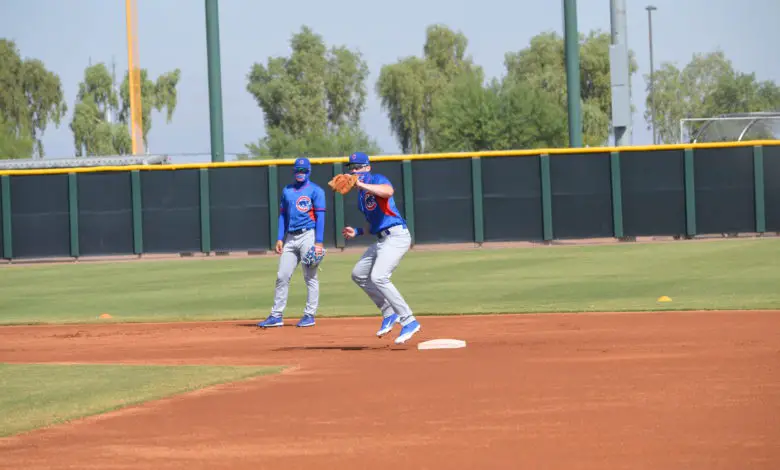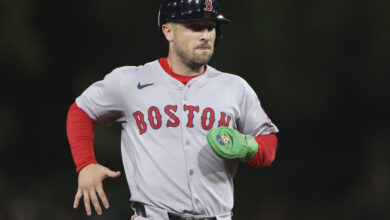
Chase Strumpf, Jordan Nwogu Headline Cubs Fall Instructs Stat Sheet
I spent the entire 2019 minor league season updating CI readers on what was happening each week down on the farm. By the time the South Bend Cubs were hoisting their Midwest League Championship trophy, I had spent 21 weeks watching more than a handful of games each week, paying close attention to pitch repertoires, breaking down batters’ swing paths, and ultimately analyzing the statistics that prospects were putting up.
Then the 2020 season came and went, and I wasn’t able to write a single Farm Report. My mind has since gone numb from over-analyzing 2019 numbers and what they may or may not mean.
So when Arizona Phil at The Cub Reporter began updating us on the news and notes from the Cubs’ spring training facility in Mesa, including box scores from most intrasquad scrimmages and games against other organizations, I was ecstatic.
I was so amped up, in fact, that I did a super nerdy thing. Starting with game one, I began collecting the information from the box scores and inputting the data into a spreadsheet. The result: 13 games worth of hitting and pitching stats including total home runs, K-rate, lineout rates among batted-ball outs, ERA, and strikes-thrown percentage. It is all (unofficially) there.
And what better way to relieve myself from a season’s worth of pent-up Farm Reports than to give a breakdown of what the numbers in Arizona tell us about some of the best Cubs prospects?
The Top Performer
I have to lead off with 2019 second round pick Chase Strumpf, who was the best hitter in the instructional league this fall. He led the team in HR (3), R (7), RBI (6), SLG (.760), and OPS (1.189) while playing both second and third base. Now that he seems to be truly healthy, finishing the 2021 campaign as high as Triple-A is not out of the question.
The Undrafted Free Agents
There were four undrafted free agents from the 2020 class playing in Mesa and all four put up terrific numbers. First baseman Matt Mervis finished second in OPS (1.150) and displayed the serious power that this system craves with two homers and three doubles in his 20 at-bats. Jacob Wetzel showed off his athleticism with a homer, a triple, and two stolen bases in 18 ABs while playing all three outfield spots.
On the pitching side, Ben Leeper out of Oklahoma State threw seven innings while generating more groundouts than flyouts (7-5) and striking out nine batters. Bailey Reid actually led the team in K-rate (save for Chris Clarke who only threw two-thirds of an inning) with a 39.3% clip in his six innings of work.
The 2020 Draftees
Speaking of the 2020 draft class, three of the team’s five selections made appearances. Young Koen Moreno toed the rubber for just one outing of two innings and first-rounder Ed Howard strolled to the plate just eight times, though he did hit a double in one of those. New large adult son Jordan Nwogu, an outfielder out of the University of Michigan, actually put up some of the best numbers of the fall league with a .389/.500/.556/1.056 slash line in 22 plate appearances.
The Pitcher(s)
I don’t want to dig into the remaining pitchers too closely as this league was definitely treated much like spring training. Pitchers were working specifically on certain skills or pitches and the numbers might not look too kind, so they shouldn’t be taken too seriously. However, one name that really stood out was Manny Espinoza. The 19-year-old logged the most innings of anyone down in Mesa and finished with a stellar 0.92 WHIP and a 7:1 K:BB ratio. Opponents only hit .227 off of him and he led the team by throwing strikes at a 67.1% rate.
The Established Bats
If you follow my writing here or listen to me over at Growing Cubs, you should be familiar with Cam Balego and Andy Weber. Balego did that little thing where he slashed .333/.353/.533/.886 in 17 plate appearances. The dude is criminally underrated in this system and now he is a full-time catcher to boot. Weber just hits doubles everywhere he goes, smacking four in Arizona to lead the team. Like I mentioned with Strumpf earlier, don’t be surprised if both of these guys get some time in Triple-A during the 2021 campaign.
Sorry, I Had To…
I didn’t want to put this section at the very end of this piece because I hate closing on a negative tone, but I feel like I need to point out some disappointing trends. Nelson Velazquez led the squad in plate appearances (30) this fall, but his .274 OPS was the worst on the team. Though he is one of my top bats in the system, his glaring issue over the past couple years has been the swing-and-miss in his game. Those numbers didn’t look any better in Mesa with a 36.7% K-rate.
Edmond Americaan is one of the best athletes this system has to offer. He is arguably the fastest man in the organization and was actually one of only seven players to have an average flyball distance of greater than 300 feet in 2019. In order to take advantage of his strength and ability to hit the ball really far, he needs to cut down strikeouts (23.6% in 2019) and grounders (67% in 2019). He wasn’t able to correct either of those issues this fall, striking out in six of his 13 plate appearances and grounding out three of the four times he put the ball in play.
The same could be said about Yohendrick Pinango’s ability to get the ball airborne. In the Dominican last year, Pinango showed an incredible ability to limit the strikeouts (6.9%), but also put the ball on the ground quite a bit (48.8%). In his 15 plate appearances this fall, he grounded out 11 times without making any outs in the air.
Remember, this 13-game sample is about as small as you can get. Now is not the time to start freaking out, unless you choose to lose your minds over someone playing well. And in that case, by all means, freak out as you see fit.
Two rising stars
We’ve gotta end on a high note here, and there is no better way to do that than by highlighting two guys that I don’t think most of the Cubs world is too familiar with. Yonathan Perlaza and Alfonso Rivas put up crazy-good numbers and should be on your radar.
Perlaza is in the process of converting from the infield to the outfield and he played all three spots out there this fall. Part of the reason he is making the switch is so he can focus on absolutely mashing the ball like he did over the last few weeks. He homered and tripled while walking in 18.2% of his plate appearances on his way to a 1.066 OPS.
Rivas, the return from the Athletics in the Tony Kemp trade, slashed .389/.571/.500/1.071 in his 28 plate appearances. Yes, that’s an OBP well above .500 thanks mostly to the fact that he walked at a 28.6% clip. No, it isn’t possible to hold that number up over the course of a season, but my god is that ridiculous to look at. In addition to his keen eye, he only struck out three times all fall. Rivas might be the most advanced hitter in the system and could see some playing time in Chicago next year, whether that is as a backup first baseman or getting some time in left field.
Again, these numbers aren’t definitive and there’s no chance for Mervis to leapfrog Miguel Amaya and Brailyn Marquez on top prospect lists because of his strong showing in the fall instructional league. At the same time, I am going to savor every single one of these numbers until we get real-life minor league games in 2021 and you are more than welcome to follow my example.

